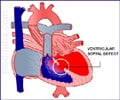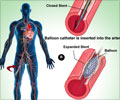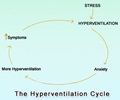A biological process that can be used to determine whether a heart disease patient is likely to suffer from a heart attack in the near future has been discovered.

"It's always been a mystery trying to identify people with heart disease who are at imminent risk of having a heart attack," says Oxana Galenko, DBMSC, with the Intermountain Medical Center Heart Institute Cardiovascular Research Laboratory, who is the lead researcher in the study. "Currently, there's no blood test that allows us to say, 'yes, this person will likely have a heart attack in the near future'. But identifying what happens to these markers has given us a place to start."
Researchers will present results of the study at the 2014 American College of Cardiology Scientific Sessions in Washington, DC, on Sunday, March 30 at 3:45 p.m. EDT.
During a heart attack, one of the coronary arteries that feed blood into the heart becomes completely blocked, preventing necessary oxygen and nourishment from reaching the heart muscle. When this happens, the heart muscle dies and never recovers resulting in heart failure or death.
The discovery of the diminishing microRNA markers began with the understanding of a basic process in biology known as the central dogma. DNA contains the genetic information an organism uses to grow and develop. Messenger ribonucleic acid (mRNA) communicates this information to the rest of the body and translates the genetic information into protein. This is known as gene expression.
In 1993 scientists discovered small forms of RNA didn't follow standard translation patterns. These forms, known as microRNA, weren't making proteins, but rather were interfering with mRNA to prevent translation.
Advertisement
Galenko and her team looked at samples in the registry from 30 patients who had suffered a heart attack within 44 days of having their blood collected.
Advertisement
The result: Galenko believes that something about these microRNAs being present and interrupting the translation process prevents people with heart disease from having a heart attack.
"MicroRNAs turn things off. Whatever they usually turn off in people with heart disease before a heart attack isn't being turned off when microRNA levels are reduced, which may be causing something else to be activated," she says. "MicroRNAs act like a watch dog, and when their levels are reduced, heart disease takes a turn for the worse and heart attacks are likely to occur."
Further research is needed to find out more about what takes place when the microRNAs disappear, says Galenko.
"We need to do additional research with more samples, but we've found a pattern that may help us understand the factors that lead to a heart attack, and we've developed a lot more questions that further research will help answer," she says.
"Ultimately, our goal is to develop a test that predicts when a heart attack is going to occur in patients with heart disease," Galenko adds. "This would help physicians intervene proactively and stop heart attacks from happening. There are monitors people wear that detect blood chemistry, and if we really wanted to look into the future, perhaps we could develop something similar, something people who are at risk for a heart attack could wear to monitor these microRNAs."
Source-Eurekalert















